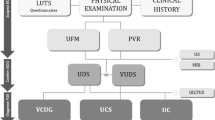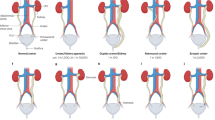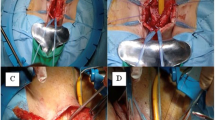Abstract
Background
Fibroblast growth factor receptor 2 (Fgfr2) deletion from murine peri-Wolffian duct stroma (ST) results in aberrant ureteric bud induction, abnormal ureteral insertion into the bladder, and high rates of vesicoureteral reflux (VUR). It is unclear which receptor docking protein(s) is/are responsible for Fgfr2 actions in these tissues. We investigated whether the docking protein, fibroblast receptor substrate 2α (Frs2α), had a role in peri-Wolffian duct ST similar to Fgfr2.
Methods
We conditionally deleted Frs2α in peri-Wolffian duct ST with a Tbx18cre mouse line (Frs2αST−/−). We assessed for ureteric induction defects and alterations in downstream targets mediating defects. We performed euthanized cystograms and assessed ureter–bladder junctions by three-dimensional (3D) reconstructions.
Results
Embryonic day (E) 11.5 Frs2αST−/− embryos had many displaced ureteric bud induction sites when compared with controls. E11.0 Frs2αST−/− embryos had decreased Bmp4 expression and signaling, which can cause abnormal ureteric bud induction. Postnatal day 1 (P1) and P30 Frs2αST−/− mice had higher VUR rates and grades vs. controls. Mutant refluxing ureters that inserted improperly into the bladder had shortened intravesicular tunnels (IVTs) when compared with controls
Conclusion
Frs2αST−/− embryos have aberrant ureteric induction sites, improper ureteral insertion, shortened intravesicular lengths, and VUR. Induction site defects appear secondary to reduced Bmp4 expression, similar to Fgfr2 mutants.
Similar content being viewed by others
Log in or create a free account to read this content
Gain free access to this article, as well as selected content from this journal and more on nature.com
or
References
Murawski IJ, Gupta IR . Gene discovery and vesicoureteric reflux. Pediatr Nephrol 2008;23:1021–1027.
Fillion ML, Watt CL, Gupta IR . Vesicoureteric reflux and reflux nephropathy: from mouse models to childhood disease. Pediatr Nephrol 2014;29:757–766.
Dressler GR . The cellular basis of kidney development. Annu Rev Cell Dev Biol 2006;22:509–529.
Mackie GG, Awang H, Stephens FD . The ureteric orifice: the embryologic key to radiologic status of duplex kidneys. J Pediatr Surg 1975;10:473–481.
Miyazaki Y, Oshima K, Fogo A, Hogan BL, Ichikawa I . Bone morphogenetic protein 4 regulates the budding site and elongation of the mouse ureter. J Clin Invest 2000;105:863–873.
Poladia DP, Kish K, Kutay B et al. Role of fibroblast growth factor receptors 1 and 2 in the metanephric mesenchyme. Dev Biol 2006;291:325–339.
Hains D, Sims-Lucas S, Kish K, Saha M, McHugh K, Bates CM . Role of fibroblast growth factor receptor 2 in kidney mesenchyme. Pediatr Res 2008;64:592–598.
Hains DS, Sims-Lucas S, Carpenter A et al. High incidence of vesicoureteral reflux in mice with Fgfr2 deletion in kidney mesenchyma. J Urol 2010;183:2077–2084.
Walker KA, Sims-Lucas S, Di Giovanni VE et al. Deletion of fibroblast growth factor receptor 2 from the peri-wolffian duct stroma leads to ureteric induction abnormalities and vesicoureteral reflux. PLoS ONE 2013;8:e56062.
Sims-Lucas S, Di Giovanni V, Schaefer C, Cusack B, Eswarakumar VP, Bates CM . Ureteric morphogenesis requires Fgfr1 and Fgfr2/Frs2alpha signaling in the metanephric mesenchyme. J Am Soc Nephrol 2012;23:607–617.
Ong SH, Guy GR, Hadari YR et al. FRS2 proteins recruit intracellular signaling pathways by binding to diverse targets on fibroblast growth factor and nerve growth factor receptors. Mol Cell Biol 2000;20:979–989.
Di Giovanni V, Walker KA, Bushnell D et al. Fibroblast growth factor receptor-Frs2alpha signaling is critical for nephron progenitors. Dev Biol 2015;400:82–93.
Sims-Lucas S, Cusack B, Eswarakumar VP, Zhang J, Wang F, Bates CM . Independent roles of Fgfr2 and Frs2alpha in ureteric epithelium. 2011 Development 138:1275–1280.
Wang Y, Tripathi P, Guo Q, Coussens M, Ma L, Chen F . Cre/lox recombination in the lower urinary tract. Genesis 2009;47:409–413.
Lebowitz RL, Olbing H, Parkkulainen KV, Smellie JM, Tamminen-Mobius TE . International system of radiographic grading of vesicoureteric reflux. International Reflux Study in Children. Pediatr radiol 1985;15:105–109.
Peters CA, Skoog SJ, Arant BS Jr et al. Summary of the AUA guideline on management of primary vesicoureteral reflux in children. J Urol 2010;184:1134–1144.
Mackie GG, Stephens FD . Duplex kidneys: a correlation of renal dysplasia with position of the ureteral orifice. J Urol 1975;114:274–280.
Boualia SK, Gaitan Y, Murawski I, Nadon R, Gupta IR, Bouchard M . Vesicoureteral reflux and other urinary tract malformations in mice compound heterozygous for Pax2 and Emx2. PLoS ONE 2011;6:e21529.
Murawski IJ, Watt CL, Gupta IR . Vesico-ureteric reflux: using mouse models to understand a common congenital urinary tract defect. Pediatr Nephrol 2011;26:1513–1522.
Author information
Authors and Affiliations
Corresponding author
Ethics declarations
Competing interests
The authors declare no conflict of interest.
Additional information
STATEMENT OF FINANCIAL SUPPORT
The study was supported by NIH grants R01 DK104374 (C.M.B.) and P30 DK079307 (Tom Kleyman, PD; CMB co-I).
Supplementary material is linked to the online version of the paper at
Rights and permissions
About this article
Cite this article
Narla, D., Slagle, S., Schaefer, C. et al. Loss of peri-Wolffian duct stromal Frs2α expression in mice leads to abnormal ureteric bud induction and vesicoureteral reflux. Pediatr Res 82, 1022–1029 (2017). https://doi.org/10.1038/pr.2017.175
Received:
Accepted:
Published:
Issue date:
DOI: https://doi.org/10.1038/pr.2017.175
This article is cited by
-
Increased rates of vesicoureteral reflux in mice from deletion of Dicer in the peri-Wolffian duct stroma
Pediatric Research (2020)



